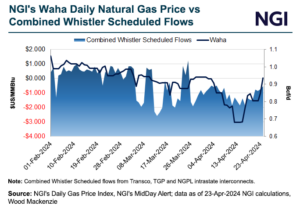Markets | NGI All News Access | NGI Data
September Natural Gas Futures Give Up More Ground as Hurricane Approaches, Temperatures Cool
September natural gas futures on Friday declined for a second day in a row as summer heat was forecast to fade, a new hurricane raced toward Florida and coronavirus-induced economic concerns weighed on markets.

The September Nymex contract shed 3.0 cents day/day and settled at $1.799/MMBtu. October fell 3.4 cents to $1.957.
NGI’s Spot Gas National Avg. dropped 14.0 cents to $1.590.
Bespoke Weather Services expected temperatures in many parts of the country to cool down over the coming week, including in the Midwest and East, with thunderstorms in the midsection of the country and Hurricane Isaias approaching the Southeast.
Weather models showed “a sizable trough diving into the middle of the nation, which pushes eastward slowly” over the first full week of August, the forecaster said. “We also expect some impact along the East Coast from Hurricane Isaias the next few days. It is not clear yet if this storm will bring demand destruction to the big cities of the East, but that is a possibility.”
Isaias strengthened into a Category 1 hurricane late Thursday, according to the National Hurricane Center (NHC). By Friday, it had crossed the Dominican Republic with sustained winds of up to 80 mph and was battering the Southeastern Bahamas with heavy rains and strong winds that threatened severe flooding. The hurricane was expected to approach Florida’s east coast by Saturday, with rain totals up to six inches in some areas over the weekend, the NHC said.
Markets on Friday also continued to assess Thursday’s Energy Information Administration (EIA) storage report, which showed a 26 Bcf injection for the week ending July 24. The build lifted inventories to 3,241 Bcf, well above the year-ago level of 2,615 Bcf and the five-year average of 2,812 Bcf.
Analysts said the latest figure, while light relative to prior weeks and only slightly above the averages of major polls, indicated that storage remains on pace to approach 4 Tcf before the end of the injection season, raising containment concerns.
“Storage peaked at an all-time high of 4.013 Tcf in October 2016,” analysts for The Schork Report said Friday. “At this point, the market remains on pace to challenge this record.”
Tudor, Pickering, Holt & Co. (TPH) said the sustained intensity of heat over most of July generated strong demand and eased the risk of filling storage.
“On the other hand, weather forecasts are trending materially cooler for August and this will likely push inventories above the high end of the five-year range through August,” the TPH analysts said. They said the latest injection “implies a roughly balanced market on a weather-adjusted basis” and expect the coming week to look “very similar, with our early modeling pointing to a build of 26 Bcf.”
The latest injection marked the fifth-consecutive week of sub-100 Bcf builds. EIA reported an injection of 37 Bcf for the week ending July 17.
However, the improvement has developed slowly, driven largely by weather, as demand for liquefied natural gas (LNG) exports continues to be weak relative to pre-pandemic levels and any near-term resurgence on this front remains dubious because of the uncertainty caused by the pandemic.
Ongoing spread of the virus in recent weeks has raised concerns about a second economic slump domestically and abroad — and that could further hamper industrial energy demand domestically as well as demand for U.S. LNG exports from Europe and Asia. In the United States, all eyes are on Congress and the debate over a second round of fiscal stimulus to provide financial support to consumers and employers as economic malaise festers. The ultimate shape of the legislation, its timing and even the odds of it passing all remain unknowns.
“In addition to cooling temperatures,” EBW Analytics Group said, “increasing coronavirus infections and the small-but-growing potential for congressional inaction on a new coronavirus relief bill may lead to a downturn in economic activity — further weakening near-term demand for natural gas.
“While the market does not yet appear to be fully pricing in anticipated declines in near-term weather-driven demand,” the EBW analysts said, “incremental demand losses could further delay a sustained recovery in Nymex natural gas.”
Spot Prices
Cash prices dropped alongside expectations for cooler weather, led by steep declines in parts of Texas and California.
“National demand is forecast to be lighter than normal next week,” NatGasWeather said. “Comfortable conditions over the Midwest and Great Lakes will slowly push into the Northeast the next few days.
“The nation’s strongest heat and demand will continue across the western and southern U.S. with highs of 90s and 100s,” the forecaster said. However, overall demand “will drop to much lighter levels” in early August, “as weather systems with showers and highs of only 70s to 80s sweep across the Midwest, Plains and east-central United States.”
Regarding tropical activity, NatGasWeather expects Isaias would “bring rain, clouds, wind and cooling to Florida,” curbing energy demand, while impacts to production are likely to be minor. “It’s possible the storm hugs the eastern U.S. coastline all the way up to New York City, with heavy squalls early next week.”
Substantial decliners Friday included points in the Permian Basin, where El Paso Permian dropped $1.00 day/day to average just 10.0 cents and Transwestern plunged $1.245 to average minus 15.5 cents.
Energy Transfer LP said late Wednesday a fire erupted at its sprawling Mont Belvieu natural gas liquids (NGL) complex near Houston, damaging the company’s Lone Star NGL facility after a contractor struck an underground pipeline. Genscape Inc. said gas was choked off as a result.
“It’s very likely gas is getting constrained because they can’t move the NGLs to their storage facility and therefore can’t process any gas,” Genscape analyst Joseph Bernardi told NGI.
In California, where prices were volatile in July, SoCal Citygate was down 33.5 cents to $2.265, and SoCal Border Avg. was off 31.0 cents to $1.920.Exceptions included Tenn Zone 6 200L, ahead 11.5 cents to $1.820, and PNGTS, up 17.5 cents to $2.975.
© 2024 Natural Gas Intelligence. All rights reserved.
ISSN © 1532-1231 | ISSN © 2577-9877 |


